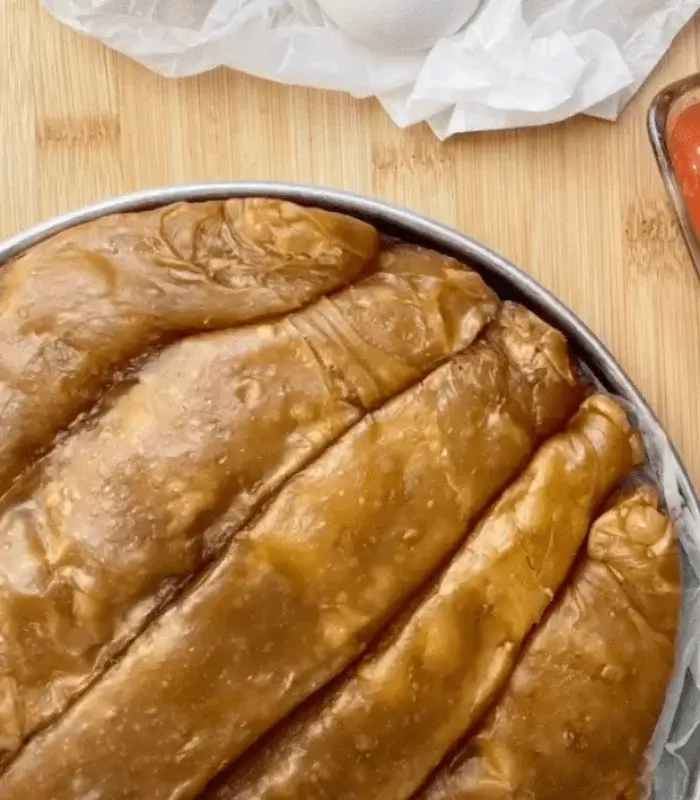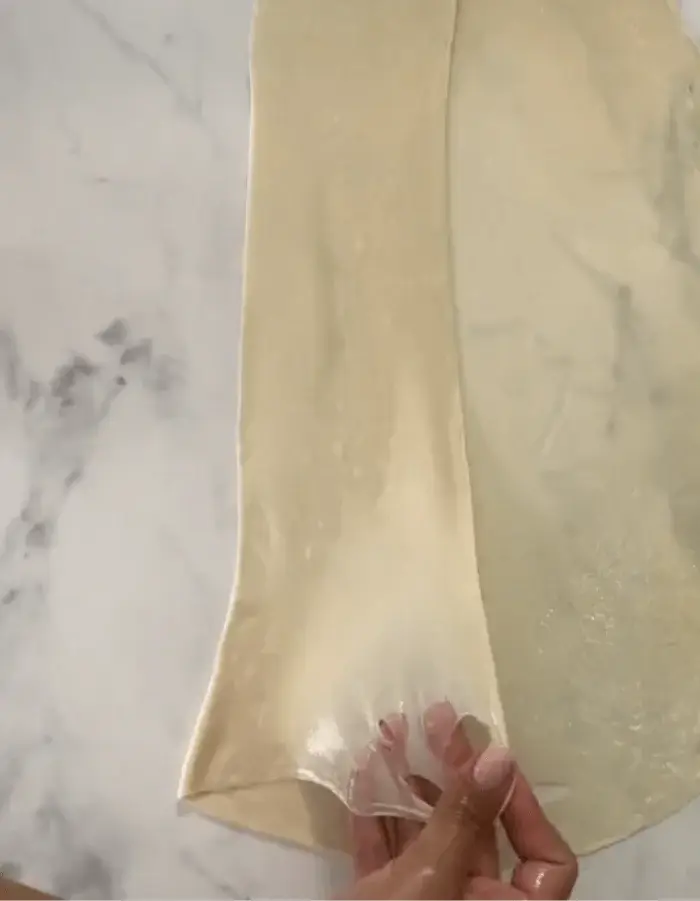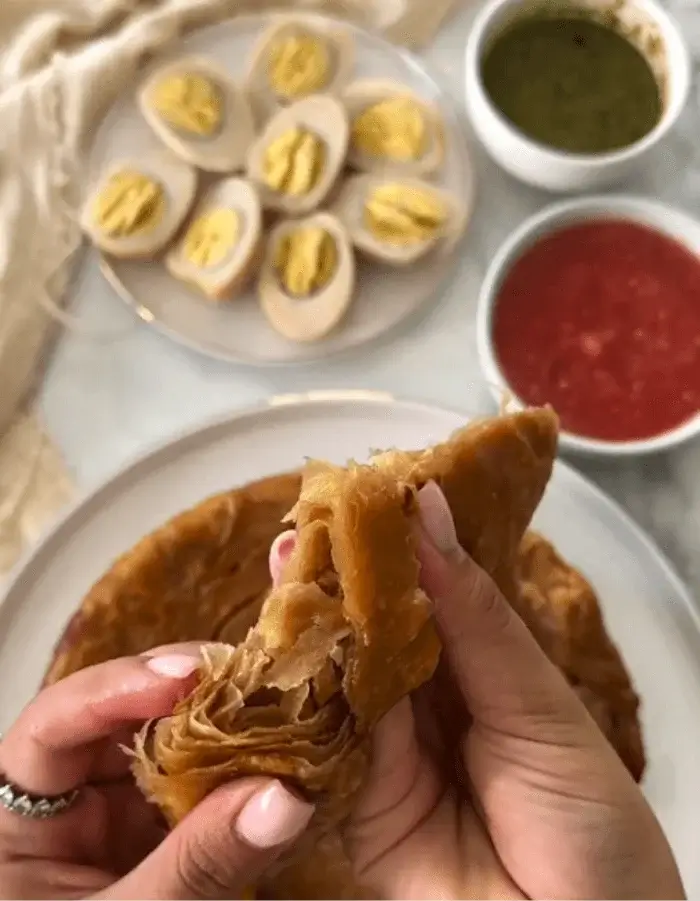Classic Jachnun Recipe
We may earn a commission from recommended products, at no extra cost to you. See Disclosure.
- Large mixing bowl
- Deep tray for soaking
INGREDIENTS
- 4 cups/1 liter oil, for soaking
- 7 ounces/200 grams unsalted butter or plant-based butter, softened
- 6 to 8 large eggs, hard-boiled
- 1 tablespoon date syrup, mixed with 1/4 cup water, for brushing (optional)
Dough:
- 7¾ cups/1 kilogram all-purpose flour
- 1/2 cup/100 grams sugar
- 1 tablespoon/10 grams baking powder
- 1 tablespoon kosher salt
- 2 tablespoons date syrup
- 2 1/3 cups/580 milliliters water, at room temperature
INSTRUCTIONS
- In the bowl of a stand mixer fitted with the dough hook, combine the flour, sugar, baking powder, salt, date syrup, and water. Mix on medium speed until a smooth, elastic dough forms, about 10 minutes. The dough should feel supple and slightly tacky, but not sticky.
- Divide the dough into 8 to 10 equal portions, about 110 grams each. Roll each into a tight ball and place in a large baking dish or tray filled with canola oil. Cover tightly with plastic wrap and let rest at room temperature for 2 to 3 hours. The oil helps soften the dough and makes it easier to stretch.
- Meanwhile, soften the butter in the microwave just until spreadable—do not melt.
- Working one piece at a time on a lightly greased work surface, gently stretch each ball into a large, nearly transparent rectangle using your hands. Avoid tearing. Spread a thin layer of softened butter over the surface. Fold the left and right sides inward to meet in the center, forming a long rectangle. Roll the dough tightly into a log, gently stretching as you go to create thin, laminated layers.
- Line the bottom and sides of a jachnun pot or heavy Dutch oven with parchment paper. Arrange the rolled jachnun logs snugly in a single layer.
- Boil the eggs in salted water for 10 minutes. Drain, then place them on a sheet of parchment set over the jachnun to prevent direct contact. Cover the pot with a tight-fitting lid.
- Bake in a 210°F/100°C oven for 12 to 14 hours, until the jachnun is deeply golden and caramelized. For a glossy finish, uncover during the final 2 to 3 hours and brush the tops with the diluted date syrup.
RECIPE NOTES
Line the bottom of the pot with a few slices of bread to prevent burning. Top with parchment paper, arrange the jachnun rolls, cover, and place the pot on the plate before bedtime. Let cook overnight, undisturbed.

FAQ
What is the best flour to use for a jachnun recipe?
For a traditional jachnun recipe, all-purpose flour is the most commonly used and yields the soft, elastic dough needed for proper stretching and layering. It provides the right balance of protein and gluten development to create the chewy, tender texture characteristic of well-made jachnun. Avoid using bread flour, which can make the dough too tough, or cake flour, which lacks the strength to hold up during the long cooking process. Stick to high-quality all-purpose flour for consistent results that match the traditional Yemenite jachnun recipe.

How do I keep the jachnun from burning during overnight baking?
Always line the bottom of your pot with parchment paper, and optionally, a few slices of bread beneath that. The parchment provides a non-stick barrier, and the bread adds an extra layer of insulation. Ensure the jachnun is tightly packed but not overcrowded, and keep the pot covered the entire time to retain moisture. Bake at a low, steady temperature of 210°F/100°C. If using a Shabbat hot plate, position the pot away from direct hot spots, and use a heat diffuser if needed.
Is there a vegan version of this jachnun recipe?
You can easily adapt a jachnun recipe to be vegan. Replace the butter with a high-quality vegan margarine or a neutral-tasting oil like refined coconut oil. Make sure the fat is softened to a spreadable consistency, not melted, for easy layering. Also, skip the hard-boiled eggs traditionally served on top, and instead accompany the jachnun with vegan-friendly sides like tomato dip, grated tomato, or zhug.
What should I serve with jachnun?
Jachnun is typically served with hard-boiled eggs, grated fresh tomato, and a spoonful of spicy zhug. The acidity and heat from the tomato and zhug balance the rich, buttery dough, making the overall dish more vibrant. You can also serve it with pickles or a simple cucumber-tomato salad for added freshness. If preparing it vegan, omit the eggs and keep the condiments.

Can I freeze the jachnun after making it?
You can freeze the rolled, unbaked dough in this jachnun recipe. After shaping each piece into a log, place them on a parchment-lined tray and freeze until firm. Then transfer the frozen jachnun rolls to an airtight container or freezer bag. When ready to bake, place the frozen rolls (no need to thaw) directly in a parchment-lined jachnun pot or Dutch oven, arrange as usual, and bake overnight at 210°F/100°C. Freezing does not affect the texture or flavor if the dough was well-prepared and wrapped properly before freezing.
How thin should the dough be for a proper jachnun recipe?
For an authentic jachnun recipe, the dough should be stretched as thin as possible—ideally until it is nearly transparent. A properly rested and oiled dough will stretch easily by hand without tearing. The thinner the dough, the more layers and caramelization you’ll achieve after the long overnight bake. It’s important not to rush this step. Use your fingers and palms to carefully stretch the dough into a wide rectangle, working from the center outward. Tear-free, ultra-thin sheets are the key to soft, flaky, golden jachnun.
Can I omit the butter and use oil instead?
While butter or margarine gives traditional jachnun its signature flavor and flaky texture, you can use oil as a substitute if needed. Choose a neutral oil with a high smoke point, such as refined sunflower or canola oil. Brush a thin layer over the stretched dough before rolling. The final texture will be slightly less rich and layered than with butter, but still soft and caramelized if baked properly.
What’s the purpose of soaking the dough balls in oil?
Soaking the portioned dough balls in oil for several hours helps relax the gluten and makes the dough extremely pliable. This rest period also ensures that the dough won’t stick during stretching and rolling, and contributes to the final glossy, soft texture. The oil barrier prevents drying out and promotes easy lamination with butter or margarine. Skipping the oil soak may result in dough that resists stretching or tears easily, which compromises the layered, rolled structure essential to jachnun.

